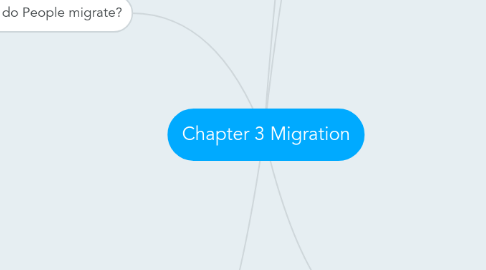
1. Field Note
1.1. A lot of people want job in Developed countries
1.2. Reagan and Clinton have made laws around this immigration
1.3. Remittance- Money that families send home
1.3.1. reverse remittance- Money they get
1.4. Not all are illegal immigrants
2. What is Migration?
2.1. Cyclic Movement- moving shorter distances away from home
2.1.1. Also called commuting
2.1.2. Nomadism- wandering, surviving with tradition
2.2. Periodic Migration- long periods away from home
2.2.1. Migrant labor- moving temporarily for work
2.2.2. Transhumance- Farmers move where the livestock want to
2.2.3. Military service- move because you're on tour
2.3. Migration- A permanent movement away from home
2.3.1. International Migration- changing home countries, the same thing as immigration
2.3.2. Internal migration- moving within a countries borders
3. Why do People Migrate?
3.1. Forced Migration- moving because they have to
3.1.1. largest forced migration is the atlantic slave trade
3.1.2. Returning illegal immigrants is a big forced migration
3.2. Voluntary migration- moving because they want to
3.2.1. The difference between those two aren't always clear
3.2.2. Men migrate more, and farther distances
3.2.3. Some forced migrants move with voluntary migrants, confusing people
3.3. Push and pull factors
3.3.1. Laws of migration
3.3.1.1. 1. every migration has a countermigration
3.3.1.2. 2. Most people move small distances
3.3.1.3. 3. Migrants who move farther tend to live in the big cities
3.3.1.4. 4. Urban migration is less likely
3.3.1.5. 5. Families are less likely to move than young adults
3.3.2. Gravity model- predicts where people will go, made by Ravenstein
3.3.2.1. Distance decay is important, and powerful
3.3.3. Step migration- people generally don't move from Stillwater to New York
3.3.4. Intervening opportunity- people want to move at the best time
3.4. Typer of Push and Pull factors
3.4.1. Legal Status
3.4.1.1. Deportation- being sent back home
3.4.2. Economic Conditions- people move where it best benefits them
3.4.3. Power relationships- gender, money, and race all tie into this
3.5. Political Circumstances- things in the country will make people migrate
3.6. Armed conflict and civil war- people don't want to live there
3.7. Environmental conditions- when the going gets tough, the tough gets going
3.8. Culture and traditions- people who want to live where their culture is strong will move to where it is if it isn't where their country is
3.9. Technological Advances- people move more because it is easier in some countries
3.9.1. chain migration- flows along and through kinship links
3.9.2. kinship links- the probability of people moving close to relatives or friends
3.9.3. Immigration waves- swells in migration from one origin to the same destination
3.9.4. kinship links- the probability of people moving close to relatives or
4. Where do People migrate?
4.1. Global Migration flows
4.1.1. global-scale migration- migration at the same time, all over the earth
4.1.2. Americas were a great site of immigration, african slaves
4.2. Regional Migration flows
4.2.1. Regional scale- people going to a neighboring country
4.2.1.1. Economic opportunities- people want to move because of money and power
4.2.1.1.1. Island of development- cities in growth
4.2.1.2. Reconnection of Cultural groups- Migration patterns of religions or ultures
4.3. National Migration flows- also called internal migration flows
4.4. Guest workers- people who migrate for work, be it regional, national or international
4.4.1. movement centered around global crisis or happenings
4.5. Refugees- people who are escaping bad things in their country emigrate quickly to places of refuge
4.5.1. internally displaced persons- people who don't have a home in their own country and can't find one
4.5.2. Asylum- the right to protection
4.5.3. repatriation- the process of returning refugees to their rightful countries
4.5.4. Regions of dislocation- places of a likelihood to get a large amount of refugees
4.5.4.1. North Africa and Southwest Asia- this region has some of the longest conflicts ever. Most of them are related to terrorists
4.5.4.2. Africa- extreme poverty and civil wars are common in this region
4.5.4.3. Genocide- mass killing of specific people
4.5.4.4. South Asia- The recuperation from the soviets and the civil war in sri lanka
4.5.4.5. Southeast Asia- Aftermath of the Vietnam war
4.5.4.6. Europe- WW2
5. How do Governments affect Migration?
5.1. Governments affect how much illegal and legal immigration, and refugees
5.2. legal restrictions- obstacles to immigration are typically legal, and not physical
5.2.1. immigration laws- helps prevent immigration to a specific country
